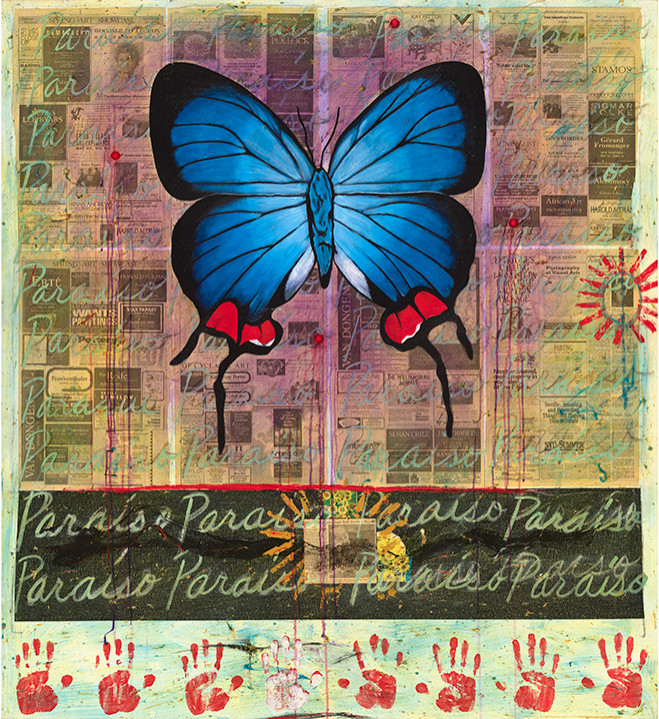
Natalia Ángeles Vierya has been around art all her life. Her first encounters with artistic expression came as a child at church, a sort of primer for visual culture for many Latino children.
Her father, a Mexican immigrant, imparted an appreciation for fine art at home, himself inspired by a relative who had worked in the Registration Department at Mexico's Instituto Nacional de Bellas Artes (the country's fine arts institute) in the 1970s. When it was time to pick a career, she had been inspired enough to flex her creative side, choosing to study Graphic Design.
It was at that point, however, that she made a realization that would change the course of her life: "I sort of discovered that I always did better in my art history classes than in my studio classes. So I made the switch to art history." That change of direction took her to a lot of places, fast. She became curator at the Worcester Art Museum in Massachusetts and held curatorial positions at the Harvard Art Museums, the Pennsylvania Academy of the Fine Arts and the Van Gogh Museum in Amsterdam. She holds a Ph.D. in art history from Temple University.
Now, that change of course has landed her a job in one of the most prestigious art institutions in the country as the first ever curator of Latinx art for the National Gallery of Art.
Vieyra's curatorship is part of a larger initiative called ALAM (Advancing Latinx Art in Museums). Launched in February 2023 by the Ford, Getty, Mellon, and Terra foundations, the project aims to pool $5 million that will fund ten Latinx art–focused curatorial positions over a five-year span.
We sat down with her to talk about her new role, the renewed interest towards Latinx art in the U.S. and inspiring the community through art.
The following interview has been edited for clarity.

How does it feel to be the first associate curator of Latinx art at the National Gallery?
It's extremely exciting. It's also very intimidating to be the first curator in such an important role. Latinx individuals are one of the largest and fastest growing demographic groups in the country.. And it's a group that's not seen a lot of representation so far in art spaces. At the National Gallery the collection is still growing. So there's so much opportunity to bring in new artists working with established artists, reaching out to community members.
What can you tell me about the ALAM (Advancing Latinx Art in Museums) initiative and it's impact so far?
It was created in response to the lack of representation of U.S Latinx artists in mainstream art institutions. So it's a first step in search of a remedy. And it I think it's been very successful so far in galvanizing interest in cultural institutions around the country creating these positions, putting a lot of attention on Latinx artists which has been sort of lacking. Aside from ALAM there's been really amazing monographic exhibitions of late, such as Pepón Osorio's Retrospective at The New Museum or María Magdalena Campos Pons at the Brooklyn Museum. So I feel Latinx artists are really having a moment right now and it's a very exciting time to be working in this field.
I also think, from an audience perspective, people want to see their own stories reflected in art and hear their narratives told at museums.
What are some of your expectations for the role you're assuming? What can be done going forward in terms of Latinx art at the National Gallery?
The focus of the National Gallery has largely been centered around European and American art by artists of European descent. And now, E. Carmen Ramos, who's the chief curator now and was my mentor during my fellowship at the Smithsonian, has dramatically changed this trajectory by making acquisitions of some very important Latinx artists. So I'm planning on building on what she's been doing in that sense which is really great.
European and American art pre-1900 is a major strength for the National Gallery of Art. So something that I would like to do is kind of think about where does Latinx art fit in that narrative. So for example take an artist like Puerto Rican Francisco Oller who was friends with the French Impressionists like Camille Pissarro or Paul Cezanne. How can artists like him be integrated into the story of nineteenth-century European painting? Same goes for contemporary Latinx artists. How can they make interventions in that space?

I read in your first official statement in your new role that you talked about inspiring the community through art. What do you think is the role of a museum in that regard?
I think that the role of the museum is to provide a forum for connection. Whether you're having human connections within a group through educational experiences, meetings with curators, conservators, those sort of things. Or whether we're talking about the connection you feel when you see a work of art. It stimulates dialog, right? And I think that's something that's really important, especially as we're coming out of the pandemic where I feel like so many people for a very long period were starved of that kind of immediate connection with physical art objects and of course with each other. I think that's something that people really want and I think art brings people together. It elevates the soul and it's healing. And I think everyone can benefit from that. So I definitely want to make sure that we're thinking about communities that perhaps haven't been in the museum space as often as others. How can we reach them? How can we ensure that the National Gallery really is for everyone in the nation?
© 2025 Latin Times. All rights reserved. Do not reproduce without permission.





